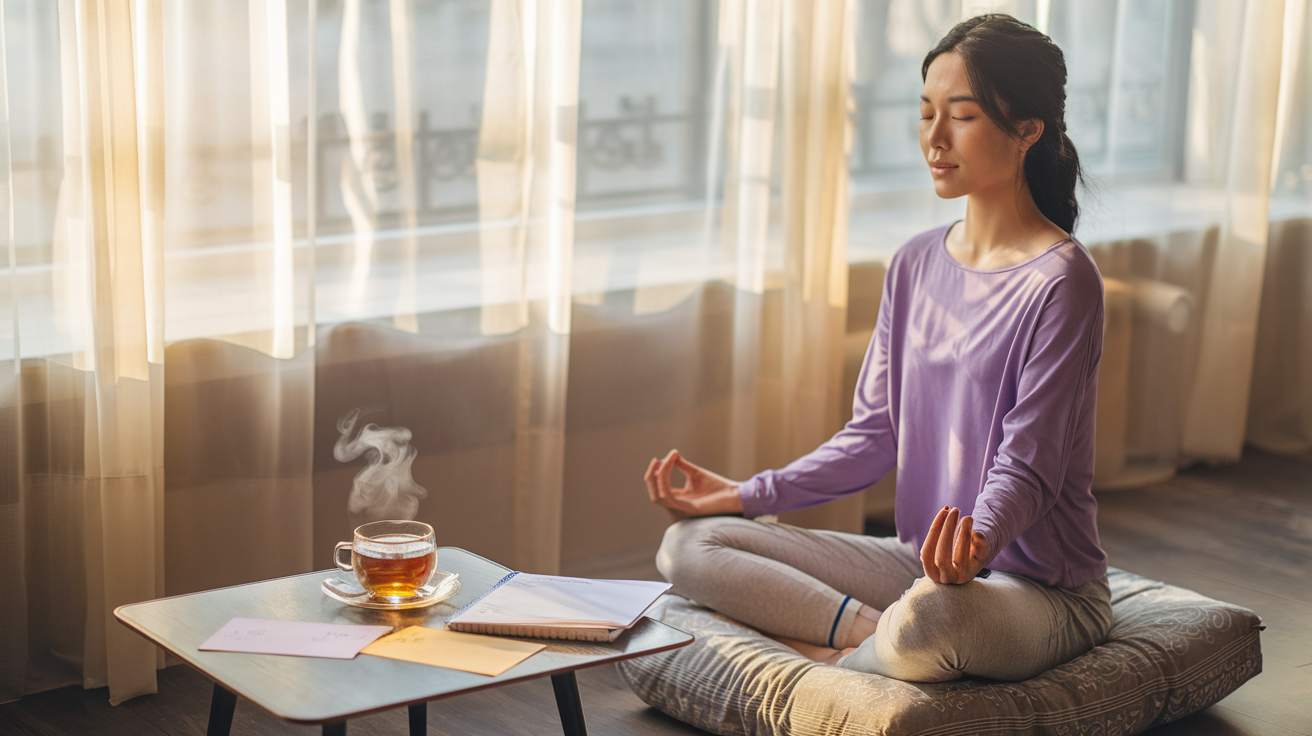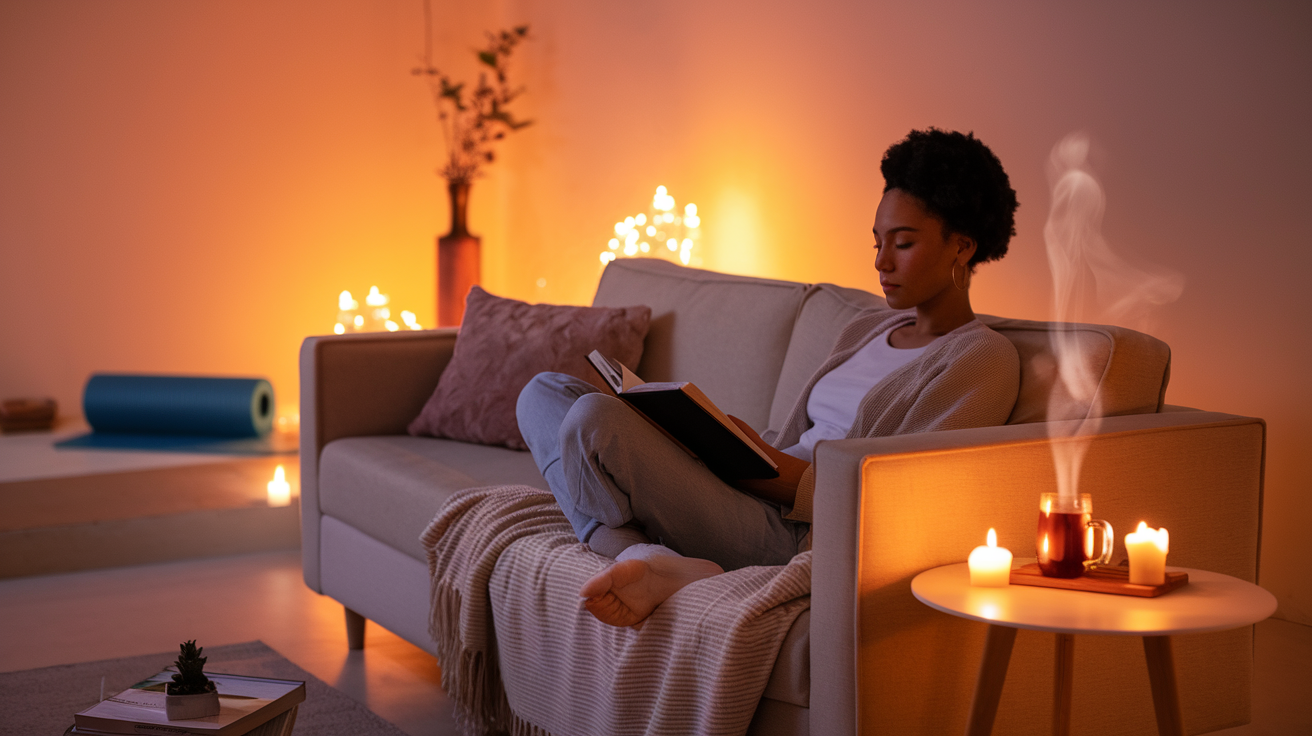
Ever wonder why some days you can rock your routine and others you barely crawl out of bed? Turns out, 68% of us struggle with consistency in our wellness habits despite knowing better.
You're not broken. You're just missing the rituals that bridge intention and action.
Daily holistic well-being isn't about grand gestures or expensive programs—it's about tiny, intentional practices that compound over time. Whether you're a burnt-out professional or simply feeling disconnected, these day-by-day rituals will reconnect you to your mind, body, and spirit.
I spent three years studying why some wellness practices stick while others fade. What I discovered changed everything about how I approach self-care.
But before I share these game-changing rituals, let me ask you something: what if the solution was simpler than you've been led to believe?
Morning Rituals for Energy and Intention

Sunrise Meditation for Mental Clarity
The first 10 minutes of your morning set the tone for your entire day. A sunrise meditation practice isn't just some woo-woo ritual—it's brain science. When you meditate as the sun rises, your body syncs with natural light cycles, triggering optimal cortisol release.
Try this simple 5-minute practice:
-
Find a comfortable seat facing east
-
Close your eyes halfway, softly gazing at the growing light
-
Breathe deeply—4 counts in, 6 counts out
-
Ask yourself: "What one thing deserves my best energy today?"
The magic happens in consistency, not perfection. Even three minutes of intentional breathing can reduce morning anxiety by 27% according to recent studies. Your phone can wait.
Hydration Practices that Energize Your Body
Coffee isn't hydration—there, I said it. Your body just spent 7-8 hours without water, and that morning fog you feel? Dehydration.
The game-changer isn't just drinking water; it's how you drink it:
-
Room temperature water absorbs faster than ice-cold
-
Add a pinch of sea salt for better cellular absorption
-
Squeeze half a lemon for a gentle liver flush
-
Aim for 16oz before anything else passes your lips
Most people wait too long to hydrate, then wonder why they crash at 2pm. Your morning glass signals to every cell that it's time to wake up and start moving nutrients where they need to go.
Nutrient-Rich Breakfast Ideas for Sustained Energy
Forget what you heard about breakfast being the "most important meal." What matters is what's on your plate.
The winning formula: protein + healthy fats + fiber.
Try these no-recipe needed options:
| Quick Option | Protein Source | Healthy Fat | Fiber Boost |
|---|---|---|---|
| Green Smoothie | Plant protein powder | Avocado or nut butter | Chia seeds + greens |
| Savory Bowl | Pasture-raised eggs | Olive oil drizzle | Roasted sweet potatoes |
| Overnight Oats | Greek yogurt topping | Walnuts | Berries + flax |
The key isn't perfection—it's avoiding the blood sugar rollercoaster. When you start with protein instead of pure carbs, you'll notice steadier energy until lunch.
Movement Exercises to Wake Up Your Body
Your body wasn't designed to jump from horizontal sleep to sitting at a desk. It needs transition time.
Morning movement isn't about burning calories—it's about circulation, joint mobility, and nervous system regulation.
Try this 4-minute wake-up sequence:
-
Cat-cow stretches (8 slow repetitions)
-
Gentle side bends (4 each side)
-
Standing forward fold with bent knees
-
Gentle twists (5 each side)
The trick? Do this before checking your phone. Morning movement primes your brain for focus and creativity, while email primes you for reactivity and stress.
Remember that consistency trumps intensity every time. A daily 5-minute movement practice delivers more benefits than an occasional 60-minute workout.
Midday Practices for Stress Management

Breathing Techniques for Instant Calm
The workday pressure is mounting. Emails keep piling up. Your boss just added another task to your already full plate. Sound familiar?
Your breath is always with you – a powerful tool to reset your nervous system in moments of stress. Try these three techniques next time you feel overwhelmed:
4-7-8 Breathing
Sit comfortably with your back straight. Inhale quietly through your nose for 4 counts. Hold your breath for 7 counts. Exhale completely through your mouth for 8 counts. The extended exhale activates your parasympathetic nervous system – your body's natural relaxation response. Repeat this cycle 3-4 times whenever tension builds.
Box Breathing
Navy SEALs use this technique in high-stress situations, and you can too. Visualize tracing a square: inhale for 4 counts, hold for 4 counts, exhale for 4 counts, hold for 4 counts. This creates a rhythm that calms your mind quickly. Three minutes of box breathing can completely shift your mental state.
Alternate Nostril Breathing
This ancient technique balances your energy immediately. Use your right thumb to close your right nostril. Inhale through your left nostril. Close your left nostril with your ring finger, release your thumb, and exhale through your right nostril. Inhale right, exhale left. Continue for 5 cycles to feel centered.
Mindful Eating Strategies for Better Digestion
Your lunch break isn't just for refueling – it's a chance to reset your entire system. Rushed eating leads to poor digestion, bloating, and afternoon energy crashes.
The 20-Minute Rule
Your brain needs about 20 minutes to register fullness. When you scarf down lunch in 5 minutes while scrolling through emails, you miss your body's natural satiety signals. Put away screens, set a timer, and commit to spending the full 20 minutes with your meal.
Chew Each Bite 20-30 Times
Digestion begins in your mouth. Thoroughly chewing breaks down food particles and signals your digestive system to prepare for incoming nutrition. The simple act of slowing down your chewing reduces bloating and improves nutrient absorption.
The Five Senses Check-In
Before eating, take 30 seconds to notice:
-
The colors and visual presentation of your food
-
The smells wafting from your meal
-
The different textures as you take each bite
-
The sounds as you chew
-
The complex flavors unfolding in your mouth
Desk Stretches to Release Tension
Hours of sitting create physical stress that compounds mental tension. These simple stretches take less than 5 minutes but deliver immediate relief:
Neck and Shoulder Relief
Drop your right ear toward your right shoulder. Place your right hand gently on your head for a deeper stretch. Hold for 30 seconds, feeling the release along the left side of your neck. Switch sides. Then roll your shoulders backward 10 times, forward 10 times.
Seated Spinal Twist
Sit tall at the edge of your chair. Place your right hand on your left knee and your left hand behind you on the chair. Inhale to lengthen your spine, exhale to twist left. Hold for 5 breaths, then switch sides. This wrings out tension from your spine and massages your internal organs.
Wrist and Finger Stretches
Extend your right arm forward, palm up. Use your left hand to gently pull your fingers back toward your body. Hold for 20 seconds, then switch hands. Next, make fists and roll your wrists in circles 10 times each direction. These movements prevent carpal tunnel and release built-up typing tension.
Afternoon Habits to Combat Energy Slumps

A. Nature Connection Breaks to Restore Focus
That 2 PM energy crash is real. You're staring at your screen, eyes glazing over, and your brain feels like mush. Instead of reaching for that third cup of coffee, try stepping outside.
Just 10 minutes in nature can reset your entire system. The Japanese call it "forest bathing" but I call it a sanity saver. The science backs this up too – exposure to natural environments reduces cortisol levels and mental fatigue.
Try these quick nature breaks:
-
Walk barefoot on grass for 5 minutes
-
Sit under a tree and just breathe
-
Tend to a small desk plant
-
Watch clouds move for 3 minutes
No nature nearby? No problem. Studies show that even looking at nature photos can provide some of the same benefits. Keep a nature scene as your screensaver or take a virtual nature walk on your phone.
B. Hydration and Snack Options for Sustained Energy
That afternoon slump often happens because you're dehydrated or your blood sugar is crashing.
Water is your best friend here. Keep a large bottle at your desk and aim to refill it after lunch. If plain water bores you, try:
-
Cucumber and mint infused water
-
Herbal teas (especially peppermint for focus)
-
Sparkling water with a splash of juice
For snacks, you want the perfect combo of protein, healthy fats, and complex carbs. Skip the vending machine chips – they'll make you crash harder.
Try these power-packed options instead:
-
Apple slices with almond butter
-
Greek yogurt with berries
-
A small handful of nuts and dark chocolate
-
Hummus with veggie sticks
-
Hard-boiled eggs with everything bagel seasoning
The key is portion control. You want just enough to fuel your brain, not so much that your body diverts all energy to digestion.
C. Digital Detox Moments for Mental Clarity
Your brain is fried from notifications, emails, and endless scrolling. A micro digital detox can work wonders.
Try these quick resets:
-
Set a 20-minute "no screens" timer and stick to it
-
Turn your phone to airplane mode for 15 minutes
-
Close all browser tabs except the one you're working on
-
Delete a social media app that's your biggest time-waster (you can reinstall later)
During your detox moments, do something analog instead. Doodle, stretch, or write in a journal with pen and paper. Your overloaded brain will thank you.
D. Power Napping Techniques for Rejuvenation
The perfect power nap is an art form. Too long and you'll wake up groggy. Too short and you miss the benefits.
The sweet spot is 10-20 minutes. Set a timer, find a quiet spot, and give yourself permission to disconnect.
For maximum nap effectiveness:
-
Use an eye mask to block light
-
Try the "coffee nap" – drink coffee right before your 20-minute nap (the caffeine kicks in just as you wake)
-
Nap sitting slightly upright to avoid deep sleep
-
Use noise-canceling headphones or white noise
Can't actually sleep? Even 10 minutes of rest with your eyes closed can restore mental clarity.
E. Brief Meditation Practices to Reset Your Mind
You don't need an hour of lotus position to benefit from meditation. Even 3-5 minutes can hit the reset button on a scattered mind.
Try these micro-meditation techniques:
-
Box breathing: Inhale for 4, hold for 4, exhale for 4, hold for 4
-
Body scan: Starting at your toes, mentally relax each body part moving upward
-
Five senses check-in: Notice one thing you can see, hear, feel, smell, and taste
-
Loving-kindness: Send positive thoughts to yourself, then someone you love
The afternoon slump doesn't have to derail your day. With these targeted habits, you can maintain steady energy and focus until evening.
Evening Rituals for Unwinding and Reflection

Technology Boundaries for Better Sleep
The blue light from your devices is wrecking your sleep cycle. It's not just annoying – it's chemical. That glow tricks your brain into thinking it's still daytime, suppressing the melatonin that would normally help you drift off.
Try this tonight: No screens 60 minutes before bed. Not negotiable. Put your phone on "Do Not Disturb" mode and charge it somewhere outside your bedroom. Your notifications can wait until morning.
Need something to do instead? Grab an actual paper book. Remember those? The tactile experience of turning pages triggers a different part of your brain than endless scrolling does. Your nervous system will thank you.
Gentle Movement Practices for Releasing Daily Tension
Your body is carrying today's stress like an invisible backpack full of rocks. Let's drop it.
A 10-minute gentle yoga flow right before bed doesn't need to be fancy. Just a few simple stretches targeting your shoulders, hips and lower back – all those places where you store tension.
Try this sequence:
-
Child's pose (30 seconds)
-
Cat-cow tilts (8 slow rounds)
-
Gentle spinal twist (30 seconds each side)
-
Legs up the wall (2 minutes)
Don't make it complicated. The goal isn't perfection – it's release.
Journaling Prompts for Emotional Processing
Unprocessed emotions don't disappear – they just show up in your dreams or tomorrow's mood. Grab a notebook and try these prompts:
-
What made me smile today?
-
What's one thing I'm carrying that I can put down?
-
What would I tell my younger self about today?
-
What am I avoiding thinking about?
The magic happens when you write without filtering. Don't edit yourself – nobody's grading this. Five minutes of honest scribbling beats an hour of overthinking.
Connection Rituals with Loved Ones
We're so busy exchanging information all day that we forget to actually connect. Real connection happens in tiny moments of presence.
With your partner or kids, try the "three good things" ritual before bed. Each person shares three positive moments from their day – big or small.
Living alone? Call one person each evening just to say goodnight. Not to plan, not to vent – just to say "you matter to me."
Or write one handwritten note each week to someone who crossed your mind. In a world of texts and emails, a physical note feels like magic.
Connection doesn't need hours – it needs intention. These tiny rituals create the invisible threads that hold us together through life's storms.
Bedtime Practices for Restorative Sleep

Sleep Environment Optimization
Your bedroom should be a sleep sanctuary – nothing more, nothing less. I've found that the right environment can be the difference between tossing all night and waking up refreshed.
Start with darkness – complete darkness. Blackout curtains aren't just for vampires; they block street lights and early morning sun that can disrupt your sleep cycles. Can't install curtains? A good sleep mask works wonders too.
Temperature matters more than you think. Studies show the sweet spot is between 60-67°F (15-19°C). Too hot and you'll wake up sweating; too cold and your body wastes energy trying to stay warm.
Now, about that phone... Keep it at least 3 feet from your head, or better yet, in another room. The blue light tells your brain "it's daytime!" even at 11 PM. And those notifications? They're sleep assassins.
Quick Sleep Environment Checklist:
✓ Dark room (blackout curtains/sleep mask)
✓ Cool temperature (60-67°F)
✓ No electronics nearby
✓ Comfortable mattress and pillows
✓ Clean, uncluttered space
Calming Tea and Natural Sleep Aids
Not all sleep help comes in pill form. Mother Nature's got your back here.
Chamomile tea isn't just your grandma's remedy – it contains apigenin, which binds to brain receptors to decrease anxiety and initiate sleep. One cup about 30 minutes before bed does the trick.
Valerian root tea packs a stronger punch. It's been used since ancient Greek times and works by increasing your brain's GABA levels – the same way many prescription sleep meds work, just gentler.
Magnesium is the secret weapon in your sleep arsenal. It regulates neurotransmitters that calm the nervous system. A small handful of almonds, a banana, or magnesium glycinate supplements can help.
Lavender isn't just pretty – its scent actually lowers heart rate and blood pressure. A few drops of essential oil on your pillow or in a diffuser might be all you need.
Body Relaxation Techniques
Your body keeps score of the day's stress. You've got to help it let go before sleep comes.
Progressive muscle relaxation is simple but effective. Start at your toes and work up, tensing each muscle group for 5 seconds, then releasing. Feel that difference between tension and relaxation. By the time you reach your face, your whole body will feel heavier, ready for sleep.
4-7-8 breathing cuts anxiety in its tracks. Inhale quietly through your nose for 4 counts, hold for 7, exhale completely through your mouth for 8. This pattern alters your oxygen levels and forces your heart rate to slow down.
Gentle stretching before bed isn't about fitness – it's about releasing the physical tension you've collected. Focus on your neck, shoulders, and lower back with slow, gentle movements.
The key is consistency. Your body learns to recognize these rituals as sleep signals. Do them nightly, and soon just starting your routine will make your eyelids heavy.
Weekly Wellness Rituals for Deeper Balance

Nature Immersion for Soul Restoration
Ever noticed how different you feel after spending time outside? That's because nature heals us from the inside out. Block out 2-3 hours each weekend for deliberate nature time.
Don't just walk through the park checking your phone. Actually immerse yourself. Feel the grass under your feet, listen to birds chatting overhead, smell the earth after rain. These sensory experiences reset your nervous system in ways no meditation app can match.
Try these weekly nature rituals:
-
Forest bathing (just wandering slowly through trees)
-
Sunrise or sunset watching (without the Instagram photo)
-
Gardening with your hands in actual dirt
-
Wild swimming in lakes, rivers or ocean
-
Stargazing away from city lights
Your body remembers its connection to natural rhythms when you give it the chance.
Social Connection Activities for Emotional Health
We're wired for connection, yet modern life keeps pushing us apart. Dedicate one evening a week to meaningful social time—not just group texts or social media scrolling.
Real connection means vulnerability. It means turning to someone and saying what's actually going on in your life. Schedule a recurring weekly dinner with friends where phones stay in pockets. Or start a walking meetup where conversations flow more naturally while moving.
The quality of these interactions matters more than quantity. One deep conversation beats dozens of shallow check-ins.
Some weekly connection rituals worth trying:
-
Cooking meals together rather than restaurant meetups
-
Game nights that spark laughter and friendly competition
-
Skill-sharing sessions where you teach each other something new
-
Volunteer work that connects you to your community
-
Joining clubs based on shared interests, not networking potential
Creative Expression for Mental Well-being
Your brain needs creative outlets to process emotions and experiences. Set aside weekly time for making something—anything—without judgment about the result.
This isn't about becoming a professional artist. It's about giving your thoughts a different language. When words fail, sometimes colors, movements, or sounds can express what you're carrying inside.
Weekly creativity can look like:
-
Freewriting in a journal without editing yourself
-
Dancing in your living room to music that moves you
-
Cooking experimental meals without following recipes
-
Drawing or painting without worrying if it "looks good"
-
Making music, even if you're a beginner
The point isn't creating masterpieces. It's giving your brain permission to play.
Reflection and Planning Practices for Life Alignment
Dedicate Sunday evenings to review and reset. This weekly ritual creates the container for everything else in your life.
Reflection isn't about beating yourself up over what you didn't accomplish. It's about noticing patterns, celebrating small wins, and making intentional adjustments.
Try this simple weekly review:
-
What energized me this week?
-
What drained me?
-
What one small change would make next week better?
-
What three priorities deserve my best attention?
This practice prevents life from happening to you and puts you back in the driver's seat.
Self-Care Indulgences to Prevent Burnout
Schedule non-negotiable pleasure into each week. Yes, actually block it in your calendar like any other important appointment.
Self-care isn't selfish—it's maintenance. Your body and mind need regular restoration to keep serving you well.
Weekly indulgences might include:
-
Proper massage (not just the quick chair version)
-
Long baths with quality oils and complete silence
-
Technology-free days where you remember what boredom feels like
-
Naps without guilt
-
Saying no to extra commitments without explaining yourself
These rituals work because they're preventative, not reactive. Don't wait until burnout hits to start caring for yourself.

Crafting daily rituals that nurture your body, mind, and spirit is essential for achieving holistic well-being. By incorporating intentional practices throughout your day—from energizing morning routines and midday stress management techniques to afternoon energy-boosting habits and calming evening reflections—you create a framework that supports your overall health. These rituals, paired with bedtime practices for quality sleep, form the foundation of sustainable wellness.
Remember that consistency, not perfection, is key to transforming these practices into life-changing habits. Start by selecting just one or two rituals from each time period that resonate with you, then gradually build your personalized wellness routine. Whether it's a five-minute meditation, a mindful walk, or a weekly digital detox, these small, deliberate actions will compound over time, helping you create a more balanced, fulfilling life. Your journey to holistic well-being begins with the very next ritual you choose to embrace.
📚 References
- Singh RH et al., 2011 – Concept of Dinacharya (daily routine) in Ayurveda and its role in preventive health
- Patwardhan B et al., 2005 – Ayurveda and integrative medicine: principles of lifestyle alignment
- Sleep Foundation – Circadian rhythm and daily energy regulation
- Frontiers in Psychology, 2018 – Mindfulness and daily rituals improve attention and emotional regulation
- Stough C et al., 2008 – Bacopa monnieri (Brahmi) enhances memory and focus (herbal support for daily wellness)
- Choudhary D et al., 2017 – Ashwagandha reduces stress and cortisol, supporting holistic wellbeing
- Cohen MM, 2014 – Tulsi (Holy Basil) as an adaptogen for stress resilience and clarity




Leave a comment
This site is protected by hCaptcha and the hCaptcha Privacy Policy and Terms of Service apply.